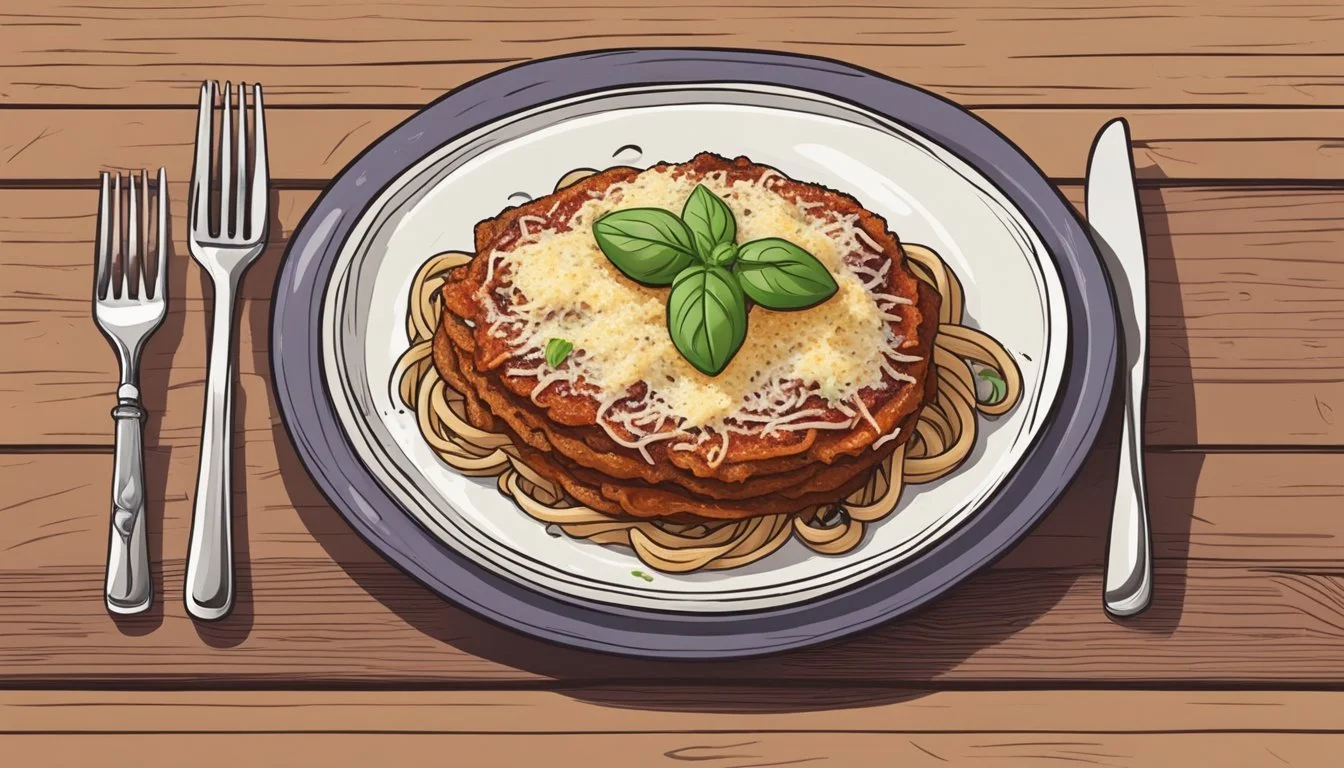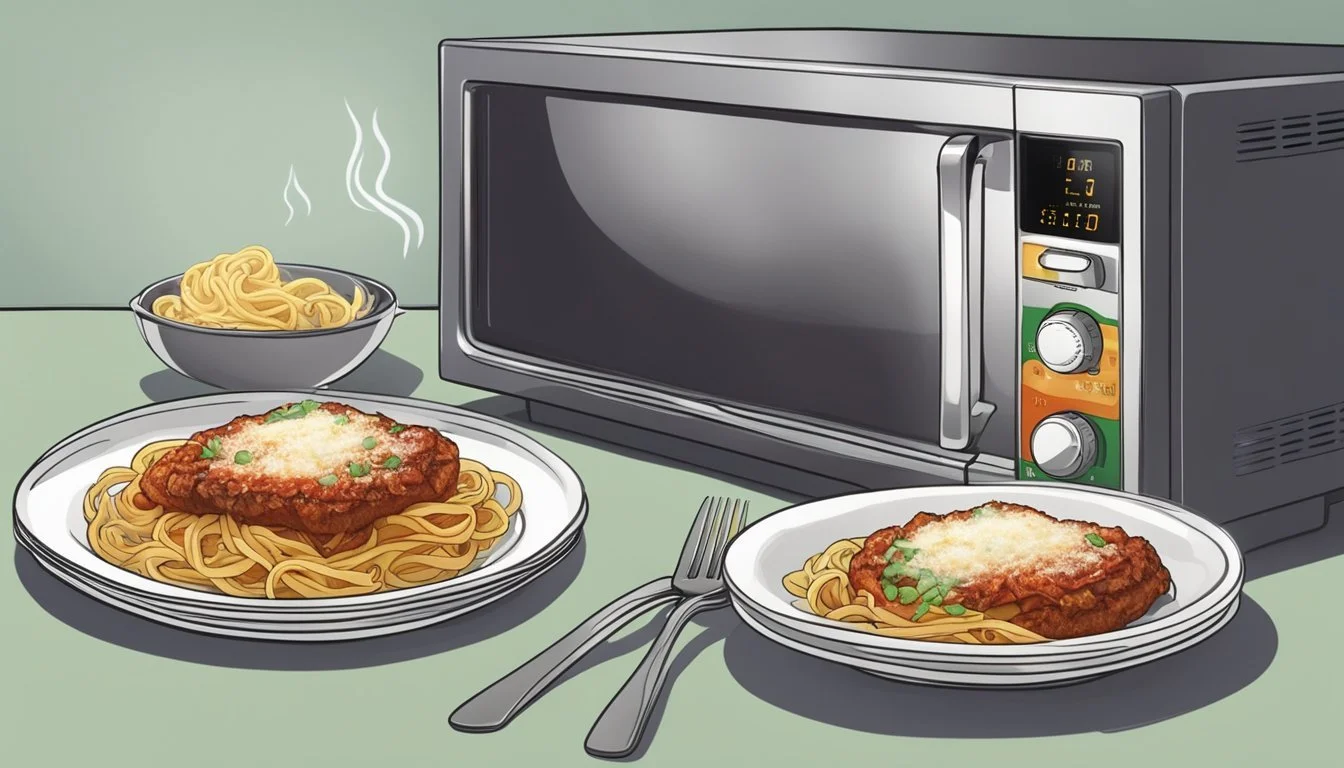How to Reheat Eggplant Parmesan with Pasta
Easy and Effective Methods
Reheating eggplant parmesan with pasta can be a delicate task, aimed at preserving the texture and flavor of both components. To reheat eggplant parmesan with pasta, place the dish in an oven preheated to 350°F (175°C), cover it loosely with foil, and heat for 10-15 minutes. This method ensures the eggplant retains its crisp coating while the pasta warms evenly without drying out.
A microwave can also be used for a quicker option. Place the eggplant parmesan and pasta in a microwave-safe container, cover it partially to retain moisture, and heat on medium power for about 2-3 minutes. Stir the pasta halfway through to ensure even reheating.
For those who enjoy a touch of added flavor and texture, reheating on a skillet with a bit of olive oil offers a satisfying result. Heat the eggplant slices and pasta over medium-high heat for a few minutes, flipping the eggplant once to ensure both sides get crispy. This method not only refreshes the dish but also enhances its overall quality.
Preparing Eggplant Parmesan for Reheating
Proper preparation ensures that eggplant Parmesan retains its flavor and texture when reheated. This involves key steps in storage to maintain quality and bringing it to room temperature for even reheating.
Storage Tips Before Reheating
After cooking and cooling, eggplant Parmesan should be stored properly to maintain its quality. Use an airtight container to keep it fresh. If storing in the refrigerator, wrap it with plastic wrap or aluminum foil before placing it in the container. For longer periods, freezing is recommended.
To freeze, wrap the dish in a layer of plastic wrap, ensuring no air pockets remain, then cover with aluminum foil. This double layer helps prevent freezer burn. Label with the date to keep track of storage time. Store it in the freezer for up to three months for best results.
Bringing to Room Temperature
Before reheating, bring your eggplant Parmesan to room temperature. This step ensures even reheating and avoids cold spots. Remove it from the refrigerator and let it sit covered at room temperature for about 30 minutes. If frozen, thaw it in the refrigerator overnight.
Avoid placing frozen or very cold dishes directly into the oven or microwave. This can cause uneven heating and affect texture. If you're in a hurry, you can use a microwave’s defrost setting, but monitor closely to prevent partial cooking.
Following these steps will help maintain the dish's quality and taste when reheating.
Choosing the Right Reheating Method
When reheating eggplant parmesan with pasta, maintaining the dish's crispy texture and even heating is crucial. Each method varies in effectiveness, depending on the available appliances and the specific qualities you're looking to retain in your leftovers.
Oven Method
Oven Use: The oven is often preferred for reheating meals like eggplant parmesan due to its ability to evenly distribute heat.
Preparation:
Preheat the oven to 350°F (175°C).
Place the eggplant parmesan in an oven-safe dish.
Cover the dish loosely with aluminum foil to prevent the top from burning.
Heat for 15-20 minutes or until the internal temperature reaches 165°F.
Benefits: Using the oven helps retain the crispiness of the eggplant coating while preventing the pasta from drying out.
Safety Tip: Always check the internal temperature to ensure it’s heated through to avoid any foodborne illness.
Skillet Method
Skillet Use: For those who want to add a bit of an extra crispy exterior, the skillet method is highly effective.
Preparation:
Heat 1-2 tablespoons of olive oil in a skillet over medium-high heat.
Place the eggplant slices in the skillet, ensuring they are spaced out.
Reheat for 3-4 minutes on each side until they are golden brown and heated through.
Benefits: Adds an additional crispy layer to the eggplant while keeping the pasta moist.
Safety Tip: Be cautious of hot oil splattering and ensure even heating by flipping the pieces as needed.
Microwave Method
Microwave Use: The microwave is the quickest and most convenient method, though it sometimes compromises texture.
Preparation:
Transfer the eggplant parmesan and pasta into a microwave-safe container.
Cover with a lid, leaving a vent for steam to escape.
Microwave on high for 3-4 minutes, stirring halfway through.
Benefits: Fast and convenient, suitable for when you're short on time.
Safety Tip: Let the dish sit for a minute after microwaving to distribute the heat evenly.
Air Fryer Method
Air Fryer Use: The air fryer method combines speed with preserving a crispy exterior.
Preparation:
Preheat the air fryer to 350°F.
Place the eggplant parmesan in the air fryer basket.
Cook for 5-7 minutes, checking periodically until heated thoroughly.
Benefits: Maintains crispiness and even reheating, making it a balanced choice.
Safety Tip: Avoid overcrowding the basket to ensure each piece is evenly heated.
Toaster Oven Method
Toaster Oven Use: A toaster oven is a good choice for smaller portions and provides similar benefits to a conventional oven.
Preparation:
Preheat to 350°F (180°C).
Place the eggplant parmesan in a toaster oven-safe dish and cover loosely with foil.
Bake for 10-15 minutes, then remove the foil for an additional 5 minutes to crisp the top.
Benefits: Ensures an even heat while maintaining the dish’s crispy texture.
Safety Tip: Be mindful of the smaller space in a toaster oven to avoid over-browning or burning.
Enhancing the Reheated Dish
To elevate your reheated eggplant parmesan with pasta, consider adding fresh ingredients and garnishing for both flavor and presentation.
Adding Fresh Ingredients
Incorporating fresh ingredients can bring a new level of flavor and moisture to your reheated dish. For example, adding extra cheese such as mozzarella or grated parmesan can create a rich and creamy texture. Fresh basil leaves provide a burst of freshness and an aromatic quality that complements the savory elements.
You can also add fresh tomatoes or a light drizzle of olive oil to enhance moisture and prevent the dish from drying out. Using spices like freshly cracked black pepper or red pepper flakes will intensify the flavors, making the dish more vibrant and appealing.
Garnishing for Flavor and Presentation
Garnishing plays a crucial role in making the reheated eggplant parmesan more appetizing and visually appealing. Grated parmesan cheese sprinkled on top adds a subtle nutty flavor and an attractive look. Fresh basil leaves not only give a pop of green color but also enhance the dish's fragrant profile.
You can also add a sprinkle of chopped parsley or a drizzle of balsamic glaze for a more gourmet feel. These simple garnishes can make a significant difference, turning a reheated dish into a delightful meal that's pleasing to the eye and palate.
Serving Suggestions
Combining reheated eggplant parmesan with pasta creates a delightful meal. Enhance the flavors and textures by pairing it with complementary sides and a well-chosen wine to elevate the dining experience.
Accompaniments to Eggplant Parmesan
Green salad is a refreshing addition, balancing the richness of eggplant parmesan. Use mixed greens, basil leaves, and a light lemon vinaigrette.
Garlic bread or crusty bread brushed with olive oil is ideal for sopping up extra tomato sauce or marinara sauce.
A sprinkle of grated cheese and black olives can further embellish both the salad and the pasta. For an Italian touch, sautéed greens or roasted vegetables, like asparagus or bell peppers, contribute additional layers of flavor and nutrition.
Wine Pairing
Choosing the right wine can enhance the flavors. A medium-bodied red, such as Chianti, pairs well with the robust flavors of eggplant parmesan.
Alternatively, a crisp white like Pinot Grigio complements the dish’s richness without overpowering it. For those preferring sparkling wines, Prosecco offers a light and refreshing counterpart. These wines accentuate the savory and tangy notes, making each bite more enjoyable.
Safety and Food Quality
Proper handling of leftover eggplant parmesan is crucial to maintain food safety. Always refrigerate leftovers within two hours of cooking to prevent bacterial growth. Use airtight containers to store the eggplant parmesan, ensuring it maintains its quality.
When ready to reheat, make sure the dish reaches a safe internal temperature of 165°F (74°C). This temperature ensures that any harmful bacteria are killed. Use a food thermometer to accurately measure the temperature.
There are various methods to reheat eggplant parmesan. The conventional oven is a popular choice, allowing for even heating and retention of food quality. Preheat the oven to 350°F (175°C) and cover the dish with aluminum foil to prevent drying out. After 15-20 minutes, check that the dish is heated through and the cheese is melted.
Microwaves can also be used for quicker reheating. Place the eggplant parmesan in a microwavable container, cover loosely, and heat on medium. Stir occasionally to ensure even heating and avoid hot spots.
When combining with pasta, ensure both components are hot before serving. Reheat pasta separately in boiling water or the microwave, then mix with the eggplant parmesan.
Storing reheated leftovers is not recommended due to potential loss of quality and increased food safety risks. Always consume reheated food promptly to enjoy the best texture and flavor.
Additional Tips for Optimal Reheating
Reheating eggplant parmesan with pasta can be tricky but following certain methods prevents common issues like moisture loss and ensures a crispy coating.
Avoiding Common Mistakes
Using an oven or a toaster oven is recommended to maintain the texture. Avoid using the microwave if possible. Microwaving can make the breading soggy and the dish unappetizing. Instead, preheat the oven to 350°F (180°C) and use an oven-safe dish.
Cover the eggplant parmesan loosely with aluminum foil to prevent drying out. If reheating frozen portions, thaw them first to ensure even cooking. Avoid reheating too quickly or on too high a temperature, which can burn the edges while leaving the center cold.
Maintaining Moisture and Crispiness
Managing Moisture: Prevent moisture loss by covering the dish with aluminum foil. This traps steam, keeping the dish moist. Adding a bit of extra sauce can also help maintain moisture. If breadcrumbs need refreshing, sprinkle fresh breadcrumbs on top before reheating.
Crispy Coating: For a crispy coating, remove the foil in the last few minutes of reheating. This allows the breaded surface to crisp up nicely. If reheating in a skillet, preheat 1-2 tablespoons of olive oil over medium-high heat and heat until crispy on both sides.
Incorporate these tips to ensure your reheated eggplant parmesan with pasta retains its delicious texture and flavor.





